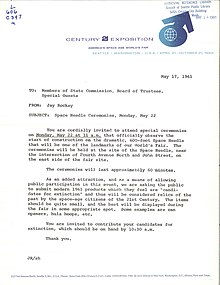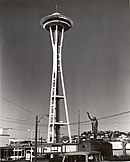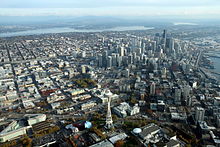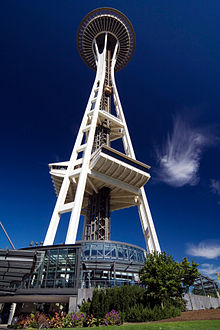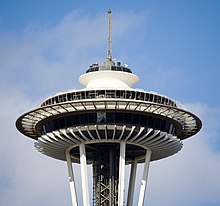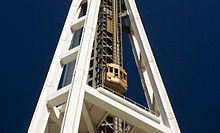Space Needle
|
Space Needle
|
|||||||
|---|---|---|---|---|---|---|---|
| Basic data | |||||||
| Place: |
|
||||||
| State: | Washington | ||||||
| Country: | United States | ||||||
| Altitude : | 38 m | ||||||
| Coordinates: 47 ° 37 ′ 13.8 " N , 122 ° 20 ′ 57.5" W. | |||||||
| Use: | Observation tower, restaurant | ||||||
| Tower data | |||||||
| Construction time : | 1961–1962 | ||||||
|
|||||||
| Last renovation (tower) : | 2018 | ||||||
| Total height : | 184.4 m | ||||||
| Total mass : | 3356 t | ||||||
| Data on the transmission system | |||||||
| Further data | |||||||
| Status: | in operation | ||||||
| Civil engineer: | John K. Minasian, Victor Steinbrueck |
||||||
| Owner: | Space Needle Corporation | ||||||
| Opening: | April 21, 1962 | ||||||
| Viewing platforms: | 30.5 m, 152.4 m, 158.5 m | ||||||
| Position map | |||||||
|
|
|||||||
Space Needle ( English for space needle ) is a 184 meter high observation and restaurant tower in Seattle , which was built for the Century 21 Exposition , the 1962 World's Fair . After the start of the construction work had dragged on, among other things due to an unresolved question of financing, it was completed on time within a year of construction. The tower was the first in North America to have a rotating restaurant. In the following decades it served as a model for numerous television and observation towers around the world.
The eighth tallest building in the city shapes its skyline and has become a symbol of Seattle. At the time of completion, the Space Needle was the second tallest structure in the United States west of the Mississippi after the pylons of the Golden Gate Bridge . The futuristic style of the Space Needle is attributed to the architecture and design form Googie and is adapted to the exhibition motto "Human life in the space age". On April 19, 1999, the city officially declared the Space Needle a historic landmark . As a tourist destination, it is visited by over a million people every year.
history
Background and planning
The chairman of the 1962 World Exhibition Commission, Edward E. Carlson, had the idea of building a tower restaurant for the event during a visit to the Stuttgart television tower in the spring of 1959 . He did extensive research on the tower and also found that it was a great success economically. The idea came about under the project name Space Needle during his visit to Stuttgart . The idea of a “restaurant in heaven” seemed to be particularly suitable for Carlson, an impressive architecture for the trade fair, but also a landmark for the exhibition motto “Human life in the space age”, which was dominated by the race into space to create the city.
The architect John Graham was commissioned to draw up appropriate plans. Graham had previously designed a revolving restaurant for the Ala Moana Center shopping mall in Honolulu and, as he held the patent for it, also proposed this for the tower in Seattle. The first drafts in the summer of 1959 envisaged a slender, stilt-like base with a tower cage . The designer Art Edwards proposed an ellipsoidal tower basket that resembled a balloon. Since Edwards did not include space for elevators in his preliminary design, he revised his work in such a way that he integrated the elevators along a spiral foot. Cables should provide additional support between the ground and the tower cage. In his proposal, a combination of the restaurant with a planetarium at the top of the tower was planned. This and other elaborations seemed quite adventurous; their static feasibility first had to be checked.
Meanwhile, the question of funding was discussed. Initial expertises indicated that the project would cost several million dollars. During a meeting on December 5, 1959 in the presence of the Governor of the State of Washington Albert Rosellini and Edward Carlson, among other things, the financing was discussed. The local television stations were also invited to participate in the project as investors. However, they waved them off and showed no interest in installing television antennas on the Space Needle.
The designers were not satisfied with the first engineering revisions, which made the tower shaft thick and solid. They found that doing so would lose his elegance. Graham brought the engineer Victor Steinbrueck into the team, who should examine the designs. Steinbrueck presented a buildable design in the summer of 1960, which already contained the curved stilts. A waist in the upper third made it appear filigree and not very sedate. The tower cage leaned outwards in continuation of the supporting pillars. Steinbrueck's draft was essentially adopted for the implemented version. Only the tower basket was adapted to the idea and was given the shape of an inverted saucer with a pagoda-like finish. While the architecture was getting closer to finding a form, the financing of the tower was still unclear in August 1960. After the involvement of three counties as investors failed, the project was financed entirely privately. Among the investors were the architect John Graham and Howard S. Wright, the owner of the construction company, as well as the businessmen Bagley Wright, Ned Skinner and Norton Clapp.
The location question remained unanswered until 1961. In addition to contractual problems, it also had to be ensured that the subsoil could support the heavy foundation. Finally, for $ 75,000, John Graham bought a square piece of land with a side length of 36.5 meters. Since the banks still refused to give a loan for the project, the purchase was processed through Graham's company. After the missing structural engineering expertise was provided and John Graham finally switched from the originally planned building material concrete to steel, a consortium of several banks agreed on March 8, 1961 to secure the financing. The company Pentagram Corporation was founded for the legal processing . The contract for construction went to the Portland- based company Howard S. Wright . Before construction began, a team led by engineering professor Alfred Lawrence Miller (1897–1965) tested a 1.82-meter-high model of the tower in the University of Washington's wind tunnel on March 24, 1961 .
Building history
Construction work began on April 17, 1961. Since the work on the building was delayed due to the long unexplained financing and the tedious finding of a plot of land, the construction work itself had to be completed with unusual speed in order to be able to complete the Space Needle in time for the world exhibition. The local press accompanied the work, as well as the preparations for the entire world exhibition, with corresponding skepticism regarding the timely completion.
The excavation work for the foundation was completed in eleven days. In the 9.10 meter deep Y-shaped excavation, a total of 250 tons of steel construction was installed, which was enclosed with concrete. Concreting, which began at 5 a.m. on May 26, 1961, took just twelve hours. During this time, 467 truckloads with a total of 5600 tons of concrete were built into the foundation block without interruption. The 27.4-meter-long and 40-tonne curved double steel legs along the tower shaft were shipped from Chicago to Seattle and then transported to the construction site for assembly by low-loader . The first steel base connected to the foundation already rose up in June 1961. In order to ensure that the 113-meter-long central section is curved, it was necessary to weld the individual parts together with L-shaped beams that are 89 centimeters long and weigh around 150 kilograms. This precision work was done by Pacific Car and Foundry’s (today: Paccar Inc. ). A climbing crane was attached to the top of the central shaft to transport the components . The crane built by Pacific Car and Foundry’s could lift parts up to 15 meters long and weighing around 45 tons. The curvature of the beams was achieved by partially heating them. After they cooled, the heating expanded the wider part more than the narrower part, producing the desired shape. No fatal accident occurred during the entire construction work. On September 1, 1961, the structure reached a height of 61 meters.
The more the tower structure took shape and its completion approached, the more it became a crowd puller. The advance sales of tickets for the world exhibition increased accordingly.
The construction work on the tower cage was completed in November, the interior work, the painting work and all structural measures were completely completed after eight months. The original color of the tower cage was a strong orange , called Galaxy Gold. The core was painted in “Orbital Olive ” and the stilt construction in “Astronaut White”. The entire painting required around 6090 liters of paint. As early as December 1961, the last components were riveted, thus completing the construction work. However, the elevators were not put into operation until April 20, 1962 - one day before the opening of the world exhibition. It took 407 days from the draft decision on March 8, 1961 to completion.
With the completion of the tower it became the tallest structure in the city and replaced the 147.5 meter high neoclassical skyscraper Smith Tower . The revolving restaurant was architect Graham's second after the one in the Ala Moana Center shopping mall in Honolulu.
During the Century 21 Exposition

The Space Needle was opened to the public on the opening day of the Century 21 Exposition . Within the exhibition grounds, the tower was on the northwestern edge adjacent to the monorail stop, the Food Circus and the Federal Science Pavilion. During the world exhibition, around 2.3 million of the total of 9,634,601 visitors to the exhibition climbed the tower. The entrance fee to the opening was $ 1 for adults and 75 cents for children. The strong rush during the world exhibition caused waiting times of up to three hours in front of the elevator. At the opening, the tower restaurant was still called the Eye of the Needle . In the beginning it was rented and operated by the company Western International Hotels . Breakfast in the restaurant was $ 6 during the fair; the average annual income in the United States in the early 1960s was around $ 4,800. On April 25th, a post office was opened on the Space Needle; it was operated throughout the exhibition. Senator Warren G. Magnuson sent the first letter through this mailroom to then President John F. Kennedy ; it was franked with the world exhibition stamp and suggested that the president visit the world exhibition. A special spectacle during the world exhibition included a stunt performance in which an artist from Circus Berlin performed hands-free stunts on a taut cable between the Memorial Stadium and the tower shaft at a height of 114.6 meters with a motorcycle and a tightrope walker in a bracket construction attached under the motorcycle demonstrated.
After the fair, the small town of Fife, located around 50 kilometers south of Seattle, offered to buy the Space Needle from Seattle for one million dollars and move it to Fife.
Since the 1960s
The Space Needle had to withstand the first major earthquake on April 29, 1965. The quake with a magnitude between 6.5 and 7.0 on the Richter scale caused the tower to wobble slightly, but did not cause it any damage. For security reasons it was closed to the public that day. Until the opening of the 192-meter-high Safeco Plaza office building in 1969, the Space Needle remained the tallest structure in the city. In 1968, the striking color scheme of the tower cage was changed to "astronaut white".
As part of an advertising campaign, an approximately 110 square meter apartment with a broadcasting room was set up for a DJ on the observation floor. In the same year, a security grille was installed on the open-air platform. By then, three suicides had thrown themselves from the viewing platform. Another suicide occurred in 1978. Further attempts to force one's way through the bars with suicidal intentions were foiled by the security forces.
In 1976 three of the five original investors Bagley Wright, Ned Skinner and Norton Clapp sold their shares in Pentagram Corporation . The remaining two investors, Howard S. Wright and John Graham, split the property between themselves in the early 1980s, leaving Wright the sole owner. Meanwhile, the stake passed to his son and chairman of the Space Needle Corporation Jeffrey Wright.
At the beginning of the 1980s, the revolving restaurant was modernized and fundamentally revised. At the same time, a two-story pavilion for receptions was set up in the lower part of the pillar construction at a height of 30.5 meters. In the late 1980s, the parking facilities at the building were expanded and the sparse entrance area was modernized. This also initiated a phase of constant changes and improvements that were gradually implemented over the next 15 years. When the National Oceanic and Atmospheric Administration began their ten-year satellite-based project to revise maps and sea maps in June 1987 , it was determined that the position of the Space Needle had to be corrected 95 meters to the south compared to the old maps. An annually recurring tradition has been established at the tower since the New Year celebrations in 1992. For this purpose, fireworks are installed along the entire structure, which are ignited at the turn of the year. The celebrations, which have since achieved a status comparable to the celebrations in New York's Times Square , are also televised nationwide.
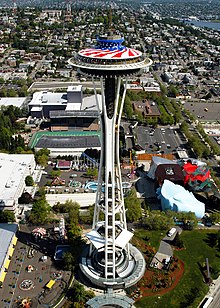
When the Olympic torch relay made its way to Atlanta for the Summer Olympic Games in Seattle in May 1996 , the event was celebrated with fireworks at the Space Needle . For the 2002 Winter Olympics in Salt Lake City , the Olympic torch made another stop at the Seattle landmark. The observation tower was repeatedly integrated into the media for special events. For example, the logos of the Washington Huskies (team from the University of Washington ), the Seattle SuperSonics or the Seattle Mariners have already been affixed to the tower basket roof to congratulate them on sporting successes . The Mariners' first playoff success was celebrated in 1995. For this purpose, an oversized baseball was attached to the lamellar ring of the viewing platform.
The most complex structural change to date was implemented in 1999 and 2000. It cost around $ 21 million, which is roughly the equivalent of the original construction costs. Based on the original planning sketches for the Space Needle, a spiral pavilion was added to the base of the tower. Since December 31, 1999, an 85 million candela strong spotlight (Skybeam) has been shining straight up from the top of the tower on national holidays and special events, optically extending it. The idea for this light installation was adapted from the 1962 world exhibition poster, on which the tower was shown with such a spotlight, although it was not equipped with it. However, due to the light pollution that occurs, its use is not without controversy, so that the originally intended use for 75 occasions a year has been reduced to around a dozen. In the first half of 2005, the Space Needle was converted to broadcast WiMAX broadband internet.
Apart from the 2.3 million visitors in the world exhibition year, the Space Needle was climbed on average between 1 and 1.2 million people, so that on May 19, 2007, the 45 millionth visitor was welcomed. The visitor from San Francisco received a trip for two to Paris including admission and a VIP dinner in the Eiffel Tower . The restaurant serves around 300,000 people annually. In May 2008, the Space Needle received professional cleaning for the first time since it opened as part of a cultural sponsorship from the Kärcher company . For this purpose, workers, secured by holding ropes, blasted the tower cage with high-pressure cleaners .
As part of the 50th anniversary celebrations, the tower cage roof was repainted in the original Galaxy Gold color in April 2012 . The color, which was only applied temporarily, was intended to accompany a number of celebrations throughout the summer and restore the retro look .
Architecture and construction technology
Location and surroundings
The Space Needle is located 38.5 meters above sea level around two kilometers north of downtown Seattle in the Lower Queen Anne district , in the so-called Seattle Center , a 300,000 square meter park with cultural and leisure activities. This means that the landmark is located north of and away from the downtown area, which is dominated by high-rise buildings . In order not to obstruct the view of the structure with tall buildings, the city issued a corresponding building ordinance on September 5, 2001, with which this will also be guaranteed in the future from several locations throughout the city.
In the immediate vicinity of the tower to the north is the Memorial Field sports facility, built in 1948, and to the northeast, the Museum for Pop Music Experience Music Project , which opened in 2000, and the headquarters of the Bill & Melinda Gates Foundation . Also nearby are the Seattle Children's Museum and the Pacific Science Center with the two IMAX cinemas Boeing IMAX Theater and PACCAR IMAX Theater on campus south of the tower . The KeyArena , used as a concert and sports hall, was known as the Seattle Center Coliseum during the World's Fair and is located northwest of the tower.
North of the Space Needle is the western stop and end point of the 1.6-kilometer-long Alwegbahn Seattle Center Monorail, which was opened for the World's Fair .
Foundation and basic structure
The Space Needle rests on 72 nine-meter-deep bolts that are anchored in a 5,306-tonne Y-shaped foundation block made of reinforced concrete . This means that the foundation is over 1.5 times as heavy as the tower, which makes it particularly stable in the event of earthquakes and storms, since the center of gravity is just 1.52 meters above the ground. The landmark survived an earthquake with a rating of 6.8 on the Richter scale . The construction is designed to withstand tremors of up to 9.1 and to withstand storms with winds of over 200 miles per hour, which is the highest level on the Saffir-Simpson hurricane wind scale . On hot days, the Space Needle expands up to 2.5 centimeters and for every 4.4 km / h wind speed it fluctuates 2.5 centimeters from the perfect vertical.
The tower structure arises from a slim tower shaft , on the outside of which two passenger elevators operate, which enter the core in the area of the cantilevered tower cage. In addition to the two elevators, there is also a freight elevator and a spiral staircase that leads in 832 steps from the base to the basket. The tower shaft is lined with three concave curved steel pillars. These are connected in the lower area in two places by horizontal intermediate levels and give the shaft a waist-like appearance due to the curvature in the upper quarter. The pillars themselves are also combined in eight places by horizontal connecting struts as a pair of two and merge in the area of the waist . Above this, the pillars, connected in pairs from below, spread apart and form six support points for the tower cage.
At the foot of the tower there has been a completely covered area since 2000 in the form of a spiral pavilion building. The structure serves as an entrance and waiting area for the elevators and houses a souvenir shop. The largely glazed pavilion consists of 634 windows on the wall facades, the roof is composed of 356 window panes, 55% of which are made of glass. The basic building has a usable area of 2136 square meters, measures 12.2 meters from floor to roof and offers space for more than 1100 people. Before the pavilion was built, the entrance was only designed as a sparsely roofed area.
The two-story SkyLine pavilion made of glass and metal is located at the height of the lowest horizontal mezzanine level at 30.5 meters . It is also called the 100-foot level because of its height in feet . It was installed in 1982 in place of the lower platform, which was intended in the original plan but was not implemented. The pavilion can be rented for various occasions by groups of between 20 and 360 people.
Tower cage and top
The four-storey cylindrical tower cage has two white lamellar rings that clearly protrude from the structure . The tower cage is closed off by a roof resembling an inverted saucer with a mast, at the top of which is the flight lights .
On the lower floor of the tower basket at a height of 152.4 meters there is a cocktail lounge, the SkyCity revolving restaurant with 300 seats and - in a separate area inside - the kitchen. The 4.26 meter wide rotatable outer ring of the projectile is mounted on rails and is integrated into the lower lamellar ring, which protrudes below the projectile like a ruff. The rotating mechanism, which is mainly based on railway technology, weighs 125 tons and is driven by a 1.1 kW electric motor. The rotating bezel needs 47 minutes to complete one full turn. On this floor, the tower cage has a diameter of 28.8 meters. The restaurant floor is glazed all around with 48 slightly inclined windows. One of the windows can be opened for cleaning. From there, a maintenance cage, which is guided on a rail, can be entered in order to clean the window front from the outside.
The second floor, which is not visible from the outside, houses offices and a unit attached to the kitchen, in which the food is served for the restaurant guests and the dishes are washed. This windowless floor is located inside the tower cage. The outer part belongs to the structure of the viewing platform and the second lamellar ring with a diameter of 42 meters. In addition to the aesthetic profiling of the tower cage, the wedge-shaped ring also serves as sun protection for the restaurant floor below.
On the third floor at a height of 158.5 meters there is the viewing level with a café and a snack bar inside. Visitors have the opportunity to have the view explained to them using interactive audio guides and to understand the history of the tower using display boards. The closed platform is surrounded all around by a balcony-like open-air platform, the end of which is formed by the lamellar ring with a larger diameter. On the observation deck, which was renovated in 2001, there are high-performance telescopes for visitors to the outside area. The view from here offers a view of the metropolitan area of Seattle, the Cascade Range to the east, Mount Rainier and the downtown skyline to the south, Elliott Bay and the Olympic Mountains to the west, and Lake Union and Mount Baker to the north.
In the fourth area, which is not accessible to the public, there is an operating floor in the sloping roof, which houses the air conditioning and the installation of heating and ventilation. The machine room of the elevator system and facilities for the fresh air supply to the tower are housed in the bulging end of the roof . The red warning light for air traffic on the top of the flagpole is operated by a gas burner that is integrated in the mast area. 24 lightning rods are attached to the tower cage, another is on the top of the tower. These are connected to a large copper ring that drains into the ground along the shaft.
Elevators
The two passenger elevators on the outside of the shaft have different colored cabins - one is blue, the other is golden yellow. Each weighs 6350 kg, can transport up to 25 people or 2041 kg load, and is carried by seven ropes that are replaced every year. For safety reasons , the rope strength is calculated so that even one rope alone could hold the weight of the cabin. In the event that all ropes were cut, an emergency braking system would prevent the cabin from falling. The counterweight of the elevators has a mass around 40% larger than the fully loaded car. The passenger cells are rounded to match the design of the building and their appearance is reminiscent of space probes .
The elevators run at a speed of 243 meters per minute and overcome the height difference to the viewing platform in 43 seconds. At high wind speeds, the elevators are reduced to half their speed. In the event of very strong storms, the Space Needle is closed to the public. The red freight elevator runs at a standard speed of 121 meters per minute and is only used occasionally for passenger transport. All elevators were replaced in 1993 for $ 1.5 million.
reception
Architectural classification
In 1999, the monument authority summarized the importance of the Space Needle for the city in their rationale for declaring the building a historical landmark as follows:
“The Space Needle marks a point in history of the City of Seattle and represents American aspirations towards technological prowess. [It] embodies in its form and construction the era's belief in commerce, technology and progress. "
“The Space Needle represents a historic milestone in the history of the city of Seattle and represents the American drive for technological capability. With its shape and construction, the tower embodies an age of belief in commercial and technological progress. "
In addition to the 324-meter-high Parisian Eiffel Tower and the 228-meter-high Tower of the Americas in San Antonio , the Space Needle is one of the tallest towers that were specially built for a world exhibition . After the Eiffel Tower, the Space Needle is one of the most famous of these structures. It is precisely the use of steel, in contrast to the reinforced concrete towers that emerged in the mid-1950s, that makes it appear like a modern answer and further development to Gustave Eiffel's masterpiece. The architecture of the tower was designed to show and reflect a vision of the space age future. The lamellar ring on the viewing platform not only makes the tower cage look flatter and like a flying saucer , but also reminds one of the Saturn rings . The revolving restaurant of the Space Needle is one of the first in the world and is considered to be groundbreaking for the construction of similar restaurants in the 1960s and 1970s. A technical design based on the three emerging, aerodynamically designed pillars can only be found in towers, some of which were built decades later, such as the CN Tower in Toronto (1976), the Stratosphere Tower in Las Vegas (1996), the Menara Alor Setar (1998) or in Macau Tower (2001).
Significance and appreciation in society
The world exhibition's press spokesman, Jay Rockey, managed to get the 1962 world exhibition to be the cover story of Life magazine twice . In the February issue, the tower basket of the Space Needle was featured on the cover picture and quickly grew into a symbol that not only stood symbolically for the exhibition and the city, but also helped the comparatively small Seattle to gain a reputation that the city in the proximity of the great metropolises of the world moved.
The US Post issued a special stamp depicting the Space Needle and the monorail for the 1962 World's Fair on April 25. The stamp with a franking of 4 cents had a circulation of 147,310,000 ( Scott catalog # 1196).
The Seattle Sounders football team, founded in 1997, has the Space Needle in its team logo. The tower has also been part of the team logo in the women's basketball team Seattle Storm since 2000 . In Gatlinburg on the edge of the Great Smoky Mountains National Park in the state of Tennessee , a 124-meter-high observation tower from 1970 also bears the name Space Needle .
The toy manufacturer Lego brought out a 57-part construction kit of the Space Needle as part of its " Architecture " series of architecturally significant structures.
Reception in the media
Due to its symbolic power for Seattle and the entire Northwest of the United States, the Space Needle has been the setting in numerous films or has accordingly been shown as an important landmark with a recognizable character.
As early as 1963, the tower was used as a location in the musical film starring Elvis Presley It Happened at the World's Fair . In the 1974 film Witness to a Conspiracy , the observation tower is used as the central site of a political assassination attempt. There is a brief chase on the roof of the structure. A futuristic Starbucks branch was set up in the tower in the agent comedy Austin Powers - Spy in a secret missionary position . The Seattle hospital series Grey's Anatomy has its main setting at the fictional Seattle Grace Hospital , whose filming location is near the Space Needle. The sitcom Frasier , which is also set in Seattle, shows the observation tower repeatedly and has included his likeness in its series logo as the city's skyline.
In the episode "Bart Sells His Soul" of the seventh season of The Simpsons , the Space Needle plays an important role in Itchy & Scratchy in "Skinless in Seattle".
Even in gloomy science fiction formats such as the Dark Angel series , the landmark is repeatedly themed and integrated as a location. In the documentary series Future Without People , the Space Needle collapses, just as in the disaster films 10.5 - The earth quakes and The Superstorm - The Weather Apocalypse (Seattle Superstorm). In both films, the tower falls to the ground. The real-time strategy game World in Conflict is set in a Cold War scenario that takes place in a destroyed Seattle, in which the tower has not been damaged. However, this can be destroyed in combat.
In the action adventure "inFAMOUS: Second Son" you have to climb the Space Needle in a mission and fight on the roof. The virtual copy there is modeled very precisely on the building.
literature
- Harold Mansfield: Space Needle USA , Craftsmen Press 1962; NA: Space Needle Story , The Writing Works, Mercer Island, Wash. 1976, ISBN 0-916076-01-6 .
- Craig A. Doherty, Katherine M. Doherty: The Seattle Space Needle , Blackbirch Pr Inc 1996, ISBN 978-1-56711-114-9 .
- Robert Spector, Petyr Beck (Eds.): The Space Needle: Symbol of Seattle , Documentary Media Llc 2002, ISBN 978-0-9719084-0-6 .
- David Littlefield, Will Jones: Ingenious constructions: masterpieces of construction and engineering from 100 years , Bucher, Munich 2008, ISBN 978-3-7658-1712-0 , p. 60.
- Erwin Heinle , Fritz Leonhardt : Towers of all times, of all cultures. DVA, Stuttgart 1997, ISBN 3-421-02931-8 , pages 252-253.
- Chad Randl (Author), Dorothy Ball (Ed.): Revolving Architecture. A History of Buildings that Rotate, Swivel, and Pivot . Princeton Architectural Press, New York, NY 2008, ISBN 978-1-56898-681-4 , pp. 106-112.
Web links
- Official website (English)
- http://www.howardswright.com/projects/detail/space-needle/ ( Memento from January 6, 2016 in the Internet Archive ) Description of the Space Needle by the construction company Howard S. Wright with historical images - Memento on web.archive. org
- University of Washington Digital Archive : Guide to the Alfred H. Fast Collection on the Space Needle. 1961–1962 - extensive collection of materials for the construction of the Space Needle
- Images: preliminary drafts for the Space Needle , schematic section through the tower cage
- Seattletimes: 'It was a crazy idea': Space Needle, 50 years later - newspaper article from April 18, 2011
- What's the weirdest thing that's happened to the Space Needle? (English)
Remarks
- ↑ Unless otherwise stated, the data in dollars always refer to the US dollar
- ↑ The incorrectly given height of 223 meters for the structure in some sources, e.g. B. in Erwin Heinle, Fritz Leonhardt: Towers of all times, of all cultures . Deutsche Verlags-Anstalt, Stuttgart 1997, ISBN 3-421-02931-8 , page 253, results from adding the height of 38 meters.
- ↑ after Doherty: The Seattle Space Needle , page 36, it is said to have been 2.75 million tower visitors
Individual evidence
- ↑ https://edition.cnn.com/travel/article/seattle-space-needle-glass-floor/index.html
- ↑ a b Randl: Revolving Architecture. , Page 112
- ↑ Andrew Garn (eds.), Paola Antonelli , Udo Kultermann, Stephen Van Dyk: World Exhibitions 1933-2005: Architektur Design Graphik , Deutsche Verlags-Anstalt 2008, ISBN 978-3-421-03696-4 , page 112.
- ↑ a b HistoryLink.org: Space Needle (Seattle) , accessed March 28, 2012
- ^ Spector: Symbol of Seattle , pp. 21-22
- ↑ Spector: Symbol of Seattle , p. 23
- ^ Biography of John Graham , accessed March 30, 2012
- ^ Spector: Symbol of Seattle , p. 26
- ^ Spector: Symbol of Seattle , p. 30
- ^ Spector: Symbol of Seattle , p.31
- ↑ Spector: Symbol of Seattle , p. 32
- ^ Spector: Symbol of Seattle , p.37
- ^ Spector: Symbol of Seattle , p. 41
- ^ Spector: Symbol of Seattle , p. 47
- ^ Spector: Symbol of Seattle , p. 49
- ^ Pacific Coast Architecture Database: Seattle World's Fair, Space Needle, Seattle, WA , accessed April 6, 2012
- ↑ Historical images of the objects in the wind tunnel ( Memento of the original from March 11, 2013 in the Internet Archive ) Info: The archive link was inserted automatically and has not yet been checked. Please check the original and archive link according to the instructions and then remove this notice. , accessed April 6, 2012
- ↑ Guide to the Alfred H. Fast Collection on the Space Needle 1961–1962 , accessed April 6, 2012
- ^ A b Spector: Symbol of Seattle , p. 53
- ^ Doherty: The Seattle Space Needle , p. 17
- ^ Spector: Symbol of Seattle , p. 52
- ^ A b Spector: Symbol of Seattle , p. 55
- ^ Spector: Symbol of Seattle , p. 54
- ^ Doherty: The Seattle Space Needle , p. 26
- ^ Spector: Symbol of Seattle , p. 56
- ^ Space Needle: The Building , accessed April 6
- ^ A b Spector: Symbol of Seattle , p. 79
- ^ Spector: Symbol of Seattle , page 85
- ↑ Popular Mechanics , February 1962, Volume 117, No. 2, p. 103
- ↑ Trip to the Fair Information Sheet ( Memento of the original from July 28, 2012 in the Internet Archive ) Info: The archive link was inserted automatically and has not yet been checked. Please check the original and archive link according to the instructions and then remove this notice. (PDF; 3.5 MB), Folder 435, Box 2, Vertical Files, VF-0000. Seattle Municipal Archives
- ^ Spector: Symbol of Seattle , p. 82
- ^ A b Spector: Symbol of Seattle , p. 61
- ^ Space Needle: Grand Opening , accessed April 6, 2012
- ↑ U.S. Income and Prices from 1900 to 1990 , accessed April 17, 2012
- ^ Doherty: The Seattle Space Needle , p. 34
- ^ Spector: Symbol of Seattle , p.11
- ^ Spector: Symbol of Seattle , p. 87
- ^ Spector: Symbol of Seattle , 63
- ↑ skyscraperpage.com: Safeco Plaza , accessed on March 28, 2012
- ^ Doherty: The Seattle Space Needle , p.31
- ^ A b Spector: Symbol of Seattle , p. 88
- ^ Spector: Symbol of Seattle , p. 66
- ^ Spector: Symbol of Seattle , page 64
- ^ Spector: Symbol of Seattle , p. 70
- ^ Spector: Symbol of Seattle , p. 68
- ^ Spector: Symbol of Seattle , page 71
- ↑ Seattle Times: Big Beam for Space Needle is Protested , Nov. 30, 1999 article.
- ^ The Seattle Times: Space Needle a launchpad for “pre-WiMax” service , May 5, 2005, accessed August 18, 2013
- ↑ spaceneedle.com: Fun Facts: The People ( Memento September 4, 2013 in the Internet Archive ), accessed on August 27, 2013
- ^ A b Spector: Symbol of Seattle , page 74
- ↑ Seattle Post-Intelligencer: Californian is Needle's 45 millionth visitor , May 19, 2007 article
- ↑ q13fox.com: Mid-life crisis? Space Needle gets dye job at 50 ( Page no longer available , search in web archives ) Info: The link was automatically marked as defective. Please check the link according to the instructions and then remove this notice. , April 20, 2012
- ↑ Viewpoints Locator Map ( Memento from June 3, 2010 in the Internet Archive ) (PDF; 633 kB), accessed on March 28, 2012
- ↑ seattle.gov: View Protection Activities. Protecting Space Needle Views ( February 22, 2013 memento in the Internet Archive ), accessed March 28, 2012
- ↑ a b c Littlefield, Jones: Ingenious constructions: Masterpieces of construction and engineering from 100 years , page 60
- ^ Spector: Symbol of Seattle , p. 80
- ^ A b Spector: Symbol of Seattle , p. 83
- ↑ spaceneedle.com: Seattle's Unique Private Event Space: Fact sheet ( Memento of May 4, 2012 in the Internet Archive ), accessed on March 29, 2012
- ↑ a b Fun Facts: The Structure ( Memento from September 4, 2013 in the Internet Archive ), accessed on August 27, 2013
- ^ Spector: Symbol of Seattle , p. 86
- ^ Doherty: The Seattle Space Needle , p. 30
- ↑ spaceneedle.com: Fun Facts: The Elevators ( Memento September 4, 2013 in the Internet Archive ), accessed on August 27, 2013
- ^ Randl: Revolving Architecture. , Page 111
- ^ Postage Stamps of the United States First Issued in 1962 , accessed March 30, 2012
- ↑ Gatlinburg Space Needle: About Us ( Memento of May 2, 2010 in the Internet Archive ), accessed March 30, 2012
- ↑ The Space Needle as a Lego kit , accessed on April 2, 2012
- ^ Simpsonspedia
- ↑ Film excerpt from 10.5 - The earth quakes , in which the Space Needle collapses , accessed on April 5, 2012
- ↑ Trailer on moviepilot.de , in which the tower falls at the end , accessed on February 23, 2016



